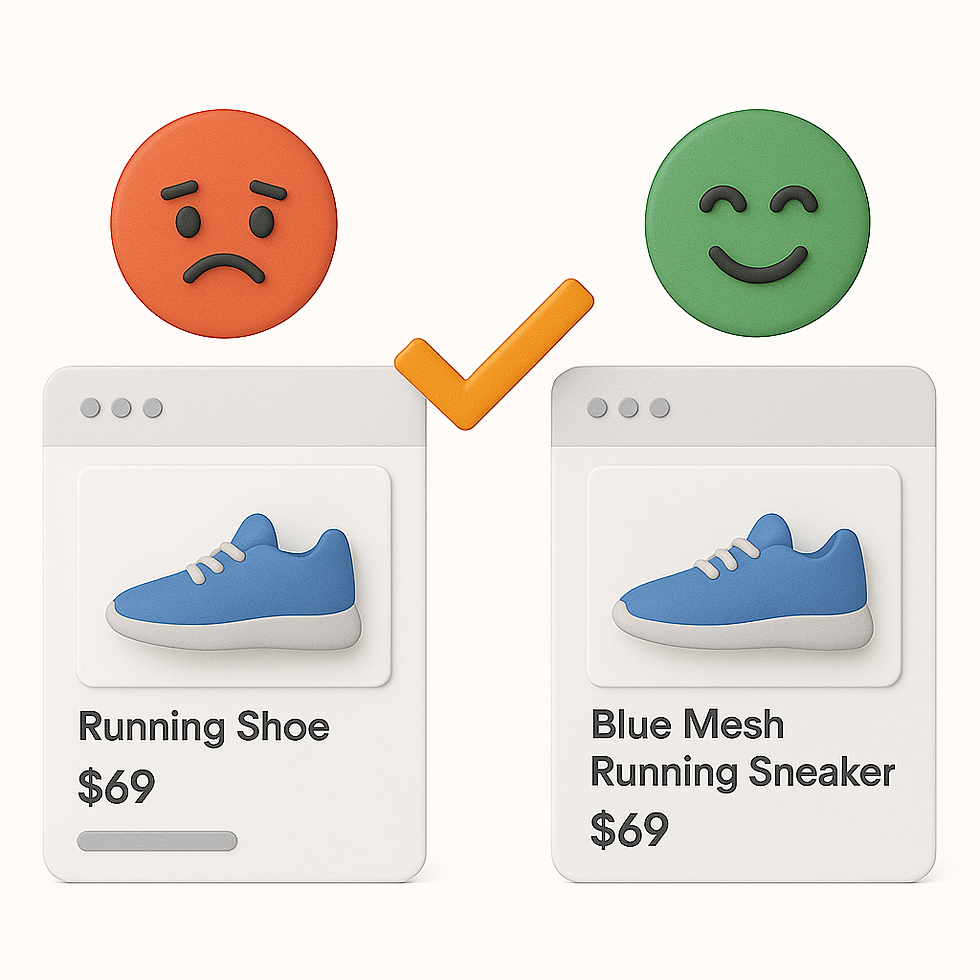Product Title Testing: How Small Changes Can Lead to Big Improvements in Shopping Ad Performance
- Adnan Agic
- Jun 10
- 5 min read
The Overlooked Power of Product Titles

In the hyper-competitive world of e-commerce advertising, marketers often focus on bid strategies, campaign structures, and budget allocations while overlooking one of the most influential elements of Google Shopping success: product titles. The humble product title is far more than a mere descriptor—it's the cornerstone of your Shopping ad's performance, influencing everything from impression share to click-through rates and conversion potential.
According to Google, product titles are among the most important attributes in your Shopping feed, directly affecting which search queries trigger your ads and how relevant they appear to potential customers. Yet many advertisers settle for manufacturer-provided titles or make minimal optimizations, missing significant opportunities for performance improvements.
This blog explores how systematic product title testing can unlock substantial gains in your Shopping campaigns, often with surprisingly small changes that lead to outsized results.
Why Product Titles Matter So Much in Shopping Ad Performance
Unlike text ads where you manually select keywords, Google Shopping uses your product data—especially titles—to determine when to show your ads. Here's why titles have such outsized importance:
Algorithm Matching: Google's algorithms heavily weight the words in your product titles when matching ads to search queries
User First Impressions: Titles are the most prominent text element in Shopping ads, making them critical for first impressions
Click Decision Factor: Shoppers often decide whether to click based primarily on the title and image
Quality Score Impact: More relevant titles improve your ad quality and can lower your CPCs
Competition Differentiation: Well-crafted titles help your products stand out in a crowded field of similar items
Even minor adjustments to title structure, keyword inclusion, or attribute order can yield surprisingly significant impacts on performance metrics.
The Science of Effective Product Title Testing
Setting Up Proper Tests For Great Shopping Ad Performance
Effective title testing requires methodical experimentation rather than random changes. Here's how to approach it scientifically:
Establish a baseline: Document current performance metrics for products before making any changes
Test one variable at a time: Change only one element (attribute order, specificity, etc.) to clearly identify what drives improvements
Segment appropriately: Test similar products together rather than comparing across different categories
Allow sufficient data collection: Give tests enough time to gather statistically significant data (typically 2-4 weeks depending on traffic)
Control for external factors: Be aware of seasonality, promotions, or competitor activities that might skew results
Key Variables Worth Testing
When designing your title experiments, consider testing these high-impact variables:
Attribute order: Does leading with brand, product type, or key feature perform better?
Specificity levels: General terms versus specific model numbers or technical specifications
Feature emphasis: Which product features or benefits drive the most engagement?
Length optimization: Short and concise versus longer, more detailed titles
Keyword integration: Including high-volume search terms versus more conversion-focused language
Special characteristics: Color, size, material, gender, etc. and their position in the title
Practical Testing Framework for E-commerce Marketers
Step 1: Audit Current Performance
Before making changes, segment your products by performance tiers and identify underperformers that present the greatest opportunity for improvement. Document baseline metrics for:
Impression share
Click-through rate
Conversion rate
ROAS/CPA
Average CPC
Step 2: Competitive Analysis
Examine how top-performing competitors structure their product titles. Use Google Shopping search results to identify patterns among top-ranked products in your category. Look for:
Common attribute orders
Specification details included
Unique selling propositions highlighted
Length patterns
Benefit-oriented language
Step 3: Design Your Test Variations
Based on your audit and competitive analysis, create 2-3 alternative title structures to test. Focus on:
Reorganizing existing attributes
Adding missing relevant specifications
Incorporating high-volume search terms
Highlighting unique selling points
Adjusting title length and specificity
Step 4: Implementation and Monitoring
Instead of changing all product titles at once, use these implementation approaches:
A/B testing: Create duplicate products with different titles in your feed (be careful with inventory settings)
Segmented testing: Test new titles on a subset of products while maintaining control groups
Sequential testing: Test changes for a defined period, then revert to measure impact
Monitor performance closely during the test period, looking for statistically significant changes in key metrics.
Step 5: Analysis and Scaling
After gathering sufficient data:
Calculate the percentage change in key metrics
Determine statistical significance
Project the potential impact of rolling out successful changes to your entire catalog
Document learnings about which title elements matter most for your products
Advanced Title Testing Strategies
Seasonal Adjustments
Modify titles to align with seasonal search patterns:
Holiday gift-oriented language during Q4
Back-to-school terminology in late summer
Weather-appropriate descriptors during seasonal transitions
Device-Specific Optimization
Consider how titles appear across devices:
Mobile devices display fewer characters, making the first 25-30 characters critical
Desktop titles can be more comprehensive
Consider testing shorter, punchier titles for mobile-heavy audiences
Competitive Differentiation
When competing in saturated markets:
Highlight unique product benefits competitors don't mention
Test including guarantees or warranties in titles
Emphasize exclusive features or limited availability
Common Pitfalls to Avoid
Title stuffing: Overloading titles with keywords damages readability and can hurt performance
Inconsistent testing: Changing multiple variables simultaneously makes it impossible to identify what's working
Premature scaling: Making catalog-wide changes before gathering sufficient data
Ignoring search term reports: Missing valuable insights about what actually triggers your ads
Static titles: Failing to regularly refresh and test titles as market conditions and search trends evolve
Conclusion: The Compound Effect of Continuous Title Optimization
The power of product title testing lies in its compound effect. While a single title change might yield a modest improvement, systematically optimizing titles across your catalog can transform your Shopping campaign performance. Even a 10-15% improvement in CTR or conversion rate can dramatically impact your bottom line at scale.
Product title testing represents one of the highest-ROI optimization activities available to e-commerce marketers. It requires minimal technical resources, can be implemented quickly, and often yields results within days or weeks.
The most successful e-commerce advertisers treat product title optimization not as a one-time project but as an ongoing program of continuous testing and refinement. By creating a systematic approach to testing, you can stay ahead of competitors and continuously improve your Shopping ad performance through the power of better product titles.
Ready to start testing your product titles? Begin with a small batch of products, make one strategic change, and measure the results. You might be surprised at how small changes can lead to significant performance improvements.
Need help optimizing your Google Shopping campaigns? Contact our team of specialists who can help you implement advanced product feed optimization strategies tailored to your specific industry and products. About the Author:
Adnan is a digital marketing specialist with expertise in e-commerce optimization. With a bachelor's degree in Business Psychology focused on online customer behavior and analysis, he brings a unique perspective to understanding shopping behaviors and conversion patterns.



Comments